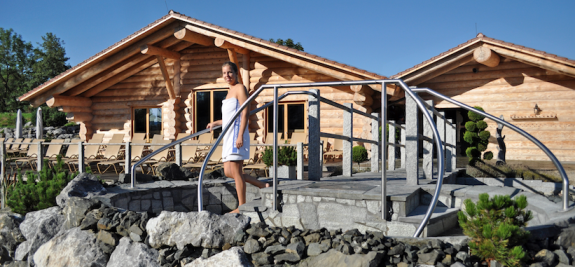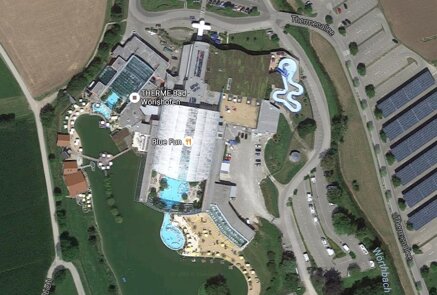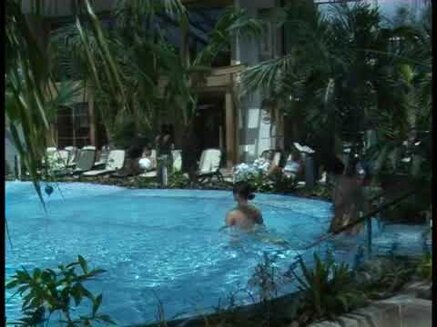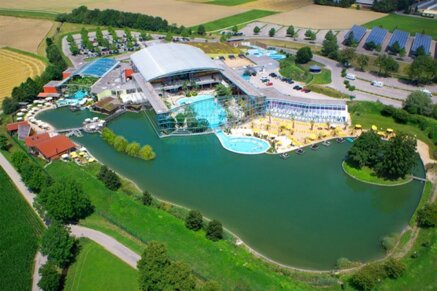© 2019. saunaway-italy.com
Therme Bad Whorishofen

The area
Bad Worishofen is a spa town in the Lower Allgau, in southern Bavaria (80 km from Munich).
The city has become famous above all because Sebastian Kneipp, a convinced supporter of the therapeutic qualities of water (hydrotherapy) and creator of the famous method that took his name and which consists of frequent bathing in cold water, worked there as a parish priest, to stimulate blood circulation, the body's thermal regulation and other basic functions such as metabolism and respiration. Immediately outside the inhabited center of Bad Worishofen, inside a forest, there is a 11 km path, which can be traveled both on foot and by bicycle, where at regular intervals you can find rest stations equipped for kneipp baths with special tanks or even directly inside the river.
Over 250 km of cycle paths and trails make the area a true paradise for enthusiasts.

The Bad Worishofen Spa
The building of the spa, seen from the outside, is truly impressive. We arrive in the afternoon around 15:00 after having spent the morning cycling to discover the surrounding woods and countryside. We leave the car in the large parking lot, right in front of the entrance portal and enter a large gallery where shops open on either side. Continuing for a few tens of meters we arrive almost at the end of the tunnel. Here we find on the left the reception to enter the thermal area and the pools, on the right that to enter the saunas area.
Above each reception bench, large billboards show the rates in the various options: 2 hours, 4 hours, daily, family, etc. We understand that the rates indicated refer to access to the spa area only. To combine the sauna you have to pay a surcharge. Same thing if the day is Sunday or any other national holiday. We approach the cash desk on the right and buy the entrance: by showing the guest card we received from the owner of our pension in total we pay in two 74 euros (1 euro discount per person), certainly not a cheap price. We wear the inevitable magnetic bracelet delivered to us by the cashier, so we enter the common changing rooms, not divided by gender. We deposit our clothes and enter the sauna area.

Vitalbad & Saunen
At the entrance we are struck by a loud sound of falling water. To our left, in fact, there is a large room, set in a cave, with an artificial waterfall in the center used for the post-sauna thermal shock. An interesting (and enjoyable) method never seen before in the various wellness centers visited. Going on, the majesty of the "tropical" scenography of the whole area strikes us even more. In front of us, in the center of the building, is the pool with hot water, equipped with sunbeds and whirlpool seats, and from which you can also reach the counter of a small bar without leaving the water.
The pool is mostly located inside the building, but through a protected passage it is possible to exit directly into a second smaller outdoor pool. Colorful flowers, plants of various types and dwarf palms surround the pool and separate it from a series of sunbeds arranged radially on the edge. Other loungers for relaxation are placed on our left on a floating floor raised about fifty cm from the ground. At the center of this relaxation area is a small round Jacuzzi that can accommodate 5-6 people. Still on the left another bar-restaurant beyond which opens the corridor leading to the textile spa area. Part of the roof and the wall in front of us are made up of huge windows and this feeds the feeling of being inside a gigantic tropical greenhouse. To our right we see the first sauna cabins while at the top on the left a large loft, accessible via an internal staircase, used as a relaxation area, under which there are additional saunas. On the right, immediately after the bar immersed in the pool, a revolving hotel-style door allows you to go outside.

Outside
We begin our exploration and, as expected, we immediately realize that the exterior is something really special. All landscape and scenographic situations are represented. At the center an artificial lake (not bathing) that develops only in a small part in the saunas area and for the rest laps the "coasts" of the largest external area of the thermal baths (clothed areas), an area that however is not visible from our position, as well as, for obvious privacy reasons, bathers in the spa area have no visibility over those in the nude area.
On the lake, on the right, a small sandy beach built in a semicircle and a large wooden jetty, host several sun beds for the full tan. Behind the beach and the wharf, three saunas built like houses, one of them is exaggeratedly huge. On the left, reachable by a wooden walkway, the hot tub is a continuation of the indoor pool, a further sauna and a small house containing sofas and a wood-burning stove (turned off during this period) for relaxation. At the end of the walkway a door leads us back inside.
Saunas (Saunaattraktionen)
There are many, between internal and external we count 12. In a day it is difficult to try them all. We list them and try to describe them:
Internal
- Römer-Sauna 65 ° C - in traditional Roman style, called the Colosseum sauna for the arena arrangement of the benches; the sessions are accompanied by classical music
- Meditationssauna 70 ° C - furnished in Japanese style, excellent for relaxing aufguss; one corner of the cabin consists of glass windows and an aquarium with tropical fish
- Alhambra 65 ° C - in Moorish style with setting of a thousand and one nights
- Backhäusle 60 ° C - in "bakery" style; in fact, at fixed times a couple of times a day, those present in the sauna are given a freshly baked hot sandwich
- Kelo-Stadl 85 ° C - classic sauna mainly used for the aufguss
- Stollen 80 ° C - another classic sauna made of pine logs
- Blaue Grotte 45 ° C - turkish bath which in the name refers to the Blue Grotto of Capri; ingenious the washing system of the seats carried out by pressing a button that releases a jet of water in a fan pattern
External
- Löyly-Hütte 90 ° C - on the white sand beach, built in a fort style. The word Loyly derives from the Finnish and identifies the water vapor produced by the steam jets
- Strandsauna 95 ° C - classic Finnish sauna built on the beach
- Blockhaus am See 80 ° C - it is an imposing sauna, also used for the aufguss, it can accommodate more than 150 people but it is usually little frequented
- Kelosauna 85 ° C - accessible from inside but the windows allow a panoramic view of the lake
- Kräuter-Sauna 55 ° C - herbal sauna enriched with extracts and essential oils
Aufguss
The program of the aufguss is almost infinite. From 10 in the morning until closing, every half hour various types of aufguss follow each other in the different cabins. We count thirty-one from the leaflet we picked up at the cash desk. It must however be said that the German aufguss are very short, they never last more than 6-7 minutes. In any case, the number is almost exaggerated. We do some with honey and salt, in Finnish, and another called La Dolce Vita (in Italian) in the Colosseo sauna, very choreographic, with a Roman tunic operator waving flags and large fans.
Conclusion
Imposing structure but still livable. Movie setting. In summer the inner area is perhaps too hot and humid, better to be outdoors. The only negative note is that the stone floor of the large 150-seat sauna is very hot.
© 2019. saunaway-italy.com
